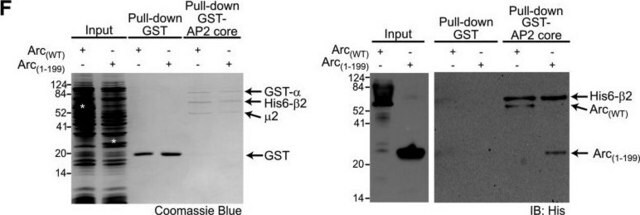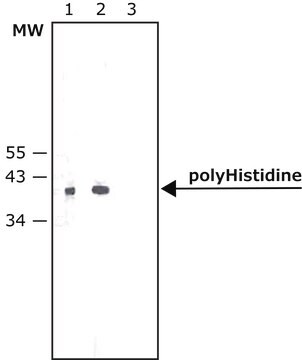A5713
Anticorps monoclonal anti-polyHistidine
clone HIS-1, purified immunoglobulin, PBS suspension, suitable for purification of HIS tagged recombinant proteins
Synonyme(s) :
Anticorps monoclonal anti-His-tag, Anticorps monoclonal anti-épitope marqueur 6 His, Anticorps monoclonal anti-épitope marqueur HHHHHH, Anticorps monoclonal anti-étiquette histidine, Anticorps monoclonal anti-étiquette 6xHis, Anticorps monoclonal anti-étiquette Hexa His, Anticorps monoclonal anti-étiquette His6, Anticorps monoclonal anti-étiquette Poly-His
About This Item
Produits recommandés
Source biologique
mouse
Niveau de qualité
Conjugué
agarose conjugate
Forme d'anticorps
purified immunoglobulin
Type de produit anticorps
primary antibodies
Clone
HIS-1, monoclonal
Forme
PBS suspension
Isotype
IgG2a
Capacité
15-30 nmol/mL binding capacity
Adéquation
suitable for purification of HIS tagged recombinant proteins
Conditions d'expédition
wet ice
Température de stockage
2-8°C
Modification post-traductionnelle de la cible
unmodified
Vous recherchez des produits similaires ? Visite Guide de comparaison des produits
Description générale
Spécificité
Immunogène
Application
Western Blotting (1 paper)
Forme physique
Notes préparatoires
Informations légales
Vous ne trouvez pas le bon produit ?
Essayez notre Outil de sélection de produits.
Code de la classe de stockage
10 - Combustible liquids
Classe de danger pour l'eau (WGK)
WGK 1
Point d'éclair (°F)
Not applicable
Point d'éclair (°C)
Not applicable
Certificats d'analyse (COA)
Recherchez un Certificats d'analyse (COA) en saisissant le numéro de lot du produit. Les numéros de lot figurent sur l'étiquette du produit après les mots "Lot" ou "Batch".
Déjà en possession de ce produit ?
Retrouvez la documentation relative aux produits que vous avez récemment achetés dans la Bibliothèque de documents.
Notre équipe de scientifiques dispose d'une expérience dans tous les secteurs de la recherche, notamment en sciences de la vie, science des matériaux, synthèse chimique, chromatographie, analyse et dans de nombreux autres domaines..
Contacter notre Service technique








